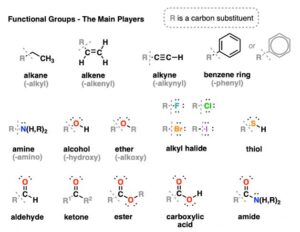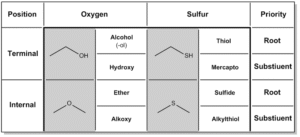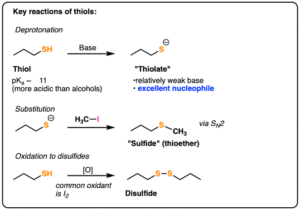Back to: Organic Chemistry 100 Level
Welcome to class!
Hello there, superstar! I’m so proud of how far you’ve come in your chemistry journey. You’re learning like a true scientist—one step at a time, and with great curiosity! Today, we’re going to look at Ethers and Thiols—two more important types of functional groups in Organic Chemistry. Even if they sound new to you now, don’t worry—you’ll soon see how they fit into everyday life around you.
Functional Groups II: Ethers And Thiols
What Are Ethers and Thiols?
Both ethers and thiols are organic compounds, but what makes them special is the type of functional group they have. Remember, a functional group is the active part of a molecule that determines how it behaves and reacts.

Let’s look at them one by one.
Ethers
Ethers are organic compounds that contain an oxygen atom connected to two alkyl or aryl groups. Think of them like a sandwich—where the oxygen is the filling and the carbon chains are the bread on either side.
General formula: R–O–R′
Where R and R′ are carbon chains (they can be the same or different).
Examples of Ethers:
Dimethyl ether (CH₃–O–CH₃) – used as a refrigerant and in aerosol sprays
Diethyl ether (C₂H₅–O–C₂H₅) – was once used as an anaesthetic
Properties of Ethers:
They are generally colourless, pleasant-smelling liquids.
Ethers are less reactive than alcohols.

They are used as solvents in industries because they can dissolve many organic substances.
Thiols
Thiols are similar to alcohols, but instead of the –OH group, they contain a –SH group (called a sulfhydryl group or thiol group).
General formula: R–SH
Examples of Thiols:
Methanethiol (CH₃SH) – has a strong smell, used in natural gas as a warning odor
Ethanethiol (C₂H₅SH) – also used for leak detection in gas lines
Properties of Thiols:
They often have very strong, unpleasant smells—like rotten eggs or onions.
Found in proteins, helping to form strong structures in the body.
They are more acidic than alcohols.
Real-Life Examples You Can Relate To
Ever smelled something really stinky like bad eggs or rotten cabbage? That’s probably a thiol!
Some strong-smelling vegetables like onions and garlic release thiols when you cut them.
Ethers are found in paint thinners, aerosol sprays, and even perfumes because they evaporate easily and don’t leave residue.
Naming Ethers and Thiols
Ethers are named by writing the two alkyl groups followed by “ether”:

CH₃–O–CH₃ → Dimethyl ether
C₂H₅–O–C₂H₅ → Diethyl ether
Thiols are named by adding “thiol” to the name of the alkane:
CH₃SH → Methanethiol
C₂H₅SH → Ethanethiol
Summary
- Ethers have an oxygen atom between two carbon groups (R–O–R′).
- Thiols have a sulfur atom bonded to hydrogen (R–SH).
- Ethers are used as solvents and anaesthetics.
- Thiols are found in natural gases, proteins, and some foods.
- Thiols have a strong, often unpleasant smell.
Evaluation
- What functional group is found in ethers?
- How is a thiol different from an alcohol?
- Give one everyday use of ethers.
- Name this compound: CH₃–O–CH₃
- Why do thiols have strong smells?
You’re doing excellently! This lesson may have introduced some unfamiliar names, but now you know how to recognise ethers and thiols, and even connect them to real-life things you’ve seen or smelled before. Keep your head high and your mind open—Afrilearn is here with you every step of the way. You’re a star, and the world is waiting for your brilliance. See you in our next class!
